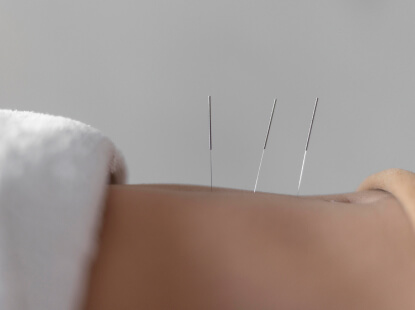Dry Needling (IMS)
Intramuscular Stimulation (IMS), also known as Dry Needling, is a comprehensive system for diagnosing and treating myofascial pain syndromes—chronic pain conditions of the musculoskeletal system. This technique employs acupuncture needles that penetrate trigger points within the muscles without injecting any substances, facilitating their release.

Trigger Points
By targeting tight bands or trigger points within the muscles, IMS has been shown to help:
- Alleviate pain and tightness in the muscles
- Relieve pain in tendons and attachments to bones (e.g., tendonitis) and increase joint range of motion
- Reduce pressure on nerves, nerve roots, and intervertebral discs (e.g., disc bulges) by lengthening shortened paraspinal muscles surrounding the spine
- Delay the onset and progression of degenerative changes within joints and the spine
Frequently Asked Questions
What is IMS?
Gunn IMS (Intramuscular Stimulation) is a physiotherapy system for diagnosing and treating soft-tissue pain. Developed in the 1970s in British Columbia by Dr. Chan Gunn, this treatment is highly effective for neuropathic and myofascial pain.
Who Will Benefit from IMS?
IMS can benefit individuals with various neuropathic disorders, including TMJ, arthritis, neck and back pain, fibromyalgia, tennis elbow, bursitis, scoliosis, headaches, whiplash, and more. Anyone struggling with stubborn knots that massage cannot release can find relief through IMS, often experiencing the equivalent of an hour’s massage on a specific knot as it releases muscle strain.
What Can I Expect to Feel During and After the IMS Program?
While dry needling can involve some discomfort, the sterile IMS needles used are very thin for added comfort. You may feel twitching in tight muscle knots as they release. Following treatment, it’s common to experience increased soreness for 1 to 3 days, but this is typically followed by significant improvement.
How Long Does an IMS Treatment Last?
The first appointment lasts about 1 hour for the initial assessment. Subsequent treatment sessions will vary based on your condition, taking into account factors such as your overall health, the duration and severity of your condition, and the presence of scar tissue. In a study of patients with low back pain, the average number of treatments required was 8.
How Long Will the Benefits of IMS Last?
The effects of IMS are cumulative. Each needle insertion stimulates healing until the condition resolves and pain diminishes. As blood flow increases to the injured tissues, it brings healing factors, such as Platelet Derived Growth Factor. This process is akin to pruning a plant: small injuries stimulate new growth, ultimately restoring your body to a pain-free state.
I’ve Had Acupuncture Before. How Is This Different?
Acupuncture treatments typically involve leaving needles in place for several minutes to an hour. In contrast, IMS treatments involve immediate insertion and withdrawal of needles. This allows for the treatment of more trigger points in a single session. Additionally, while traditional acupuncture points are often shallow, IMS targets deeper trigger points within the muscles to effectively release tension.
Traditional acupuncture relies on ancient philosophies and is practiced by Traditional Chinese Medicine (TCM) practitioners, while Gunn IMS is based on modern Western medicine’s understanding of anatomy and neurology for the diagnosis and treatment of chronic pain conditions. Learn more about the differences between IMS and acupuncture.
How Does Gunn IMS Differ from Other Dry Needling Practices?
Unlike many other dry needling practices that focus solely on the area of pain, Gunn IMS assesses and treats the entire body. For example, if you have arm or leg pain, Gunn IMS will address both the local pain and its sources, often located in the neck or back.
Is IMS Part of Physiotherapy Treatment or Billed Separately?
IMS is a specialized skill and certification for physiotherapists and is considered part of physiotherapy treatment. Your physiotherapist will evaluate whether IMS is suitable for you during a proper assessment, just like any other treatment technique in their toolkit.
